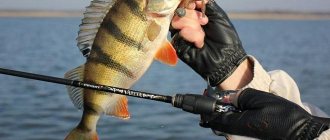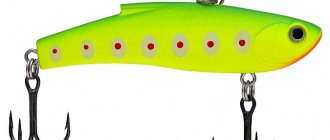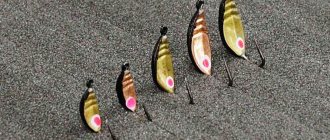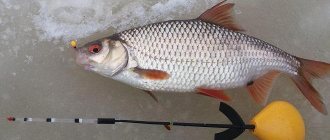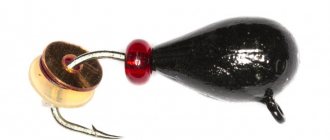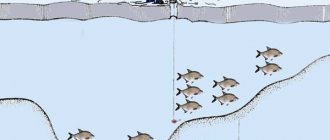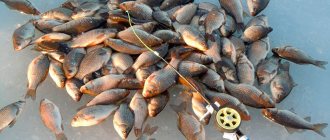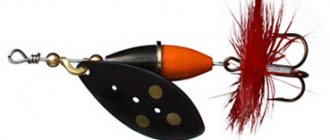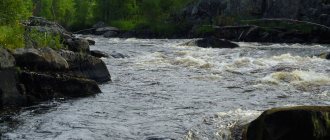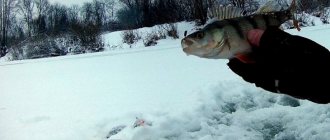Fishing with a jig is one of the most popular types of winter fishing. Jigs are suitable both for fishing in the first days of winter on first ice, and in the dead of winter, when they prove to be the most catchy bait.
The jig, being a traditional domestic tackle, has acquired many types, shapes, materials and colors during its existence. For this reason, a novice fisherman, purchasing his first gear for winter fishing, is somewhat lost in the available variety, not knowing which jigs are the most catchy for the fish he is targeting.
Our top is intended to help in this matter. Here you can find both universal ones that work for many types of fish, as well as the best jigs for certain types of fish such as perch, roach or bream. All of them are time-tested and used by thousands of anglers. We will not specify places in the rating, since the selection of such bait is very individual for different types of fish, types of reservoirs and the manner of playing with the bait. We will talk about the types of jigs, since their size, weight and color and additional equipment again depend on the depth of the reservoir, the current, the types and size of the fish living there. As for the material, now the most effective and popular are tungsten alloy baits.
Pellet.
This is one of the simplest and at the same time universal jigs. It is a hook with a pellet attached to the upper part of the fore-end, initially just lead. Now pellets come from various materials, sizes from 1 to 20 mm, and all kinds of colors. The forend of the “Drobinka” is long enough so that the pellet does not interfere with the count when biting. The bait is tied through a hole in the pellet so that the shank of the hook is perpendicular to the fishing line.
Typically, the “Drobinka” jig is used with a nozzle, and is designed to deliver it to the desired depth, including in the current. When diving by itself, it practically does not play, but when it comes into contact with the bottom, it creates a maximum cloud of turbidity, attracting fish.
The “pellet” can also be used as a “rewinder” by attaching beads, plates, cambrics, etc. to a hook. bright colors.
The “pellet” is successfully used for catching perch, roach, bream, and other white fish, but most species of fish, including predatory ones, bite well on it.
The purpose of baitless jigs is to imitate the movement of various insects. Therefore, their color is not as important as the shape and way of playing. The main thing for a jig is the correct wiring, and its “beauty” is more designed for the fisherman, and not for the fish.
Fishing rods for winter fishing for perch and their features
The winter fishing rod for perch is one of the most diverse types of fishing rods. This is because perch is a very popular fish species that easily gets into a fisherman’s backpack in winter. It is difficult to name another fish that bites well on both live and artificial bait. Accordingly, the equipment for this picky predator is very diverse.
Humpback (the common name for perch) is hooked both at the beginning of winter and at its end. In winter, the predator develops a special appetite. In order to have an excellent catch, a winter fishing rod for perch must be assembled and adjusted in accordance with seasonal characteristics.
In various conditions, avid fishermen use the following types of gear:
- A fishing rod with an attached jig. The most common fishing tackle. In addition to perch, almost all types of fish can be caught with it. We can say with confidence that if a fisherman gets on the ice with such a fishing rod, then he will definitely not return without catch. It consists of a fishing rod (fishing rod handle) with a device for fishing line, a short whip (10-20 cm) and a nod for signaling a bite. The thickness of the line reaches from 0.06 to 0.14 mm. The bait is bloodworms.
- Mothless. This name is given to a light fishing rod, intended mainly for sport fishing for active perch. Its composition is the same as that of the tackle with a nozzle, only the fishing rod is lighter, for a long, long game with fish. Often, amateur fishermen make such a fishing rod for themselves.
- Lightweight fishing rod. Lightweight compact spinners are used for artificial baits, for example, small balancers, small fish made of silicone, miniature vertical spinners, amphipods. The length of the whip is usually 30-40 cm. Due to the inability to clearly grasp the process of fish biting, the fishing rod is equipped with a nod. There may or may not be a reel in this type of gear. A characteristic difference is the short fishing rod. The fishing line used is your choice: monofilament, with a monofilament diameter of 0.16-22 mm, or braided line - 0.08 - 0.12 mm.
- Heavy fishing rod for trolling. Designed for fishing, the purpose of which is large species of perch and pike. Strict requirements are imposed on such gear, since the fishing line has to be equipped with a heavy spoon or large balancers. The thickness of the fishing line is 0.20-0.28 mm for monofilament, and 0.14-0.18 for braided line. The basis of this type is a long and strong fishing rod, the length range of which is 50-70 centimeters. For such a fishing rod you need a powerful reel that not only stores the fishing line, but also helps to pull large prey out of the hole. The reel's braking system must be perfectly tuned and should not fail at the most crucial moment.
- Zherlitsa. This is the name of a winter fishing rod for perch, or any other predator that bites on live bait. The bait for humpback fish is slightly different from the classic one designed for catching pike. This is due to the fact that perch is an active fish; it does not need to sit for a long time and wait for a predator to swallow the bait. It is necessary to pull out the rod as soon as the flag twitches. And the size of the tackle for perch is a little smaller than usual. The fishing line is thin, only 0.14-0.18 mm. Sinker of 4-6 grams, without a leash. The flag is softer and more delicate, so that it works instantly from a slight pull of a small perch.
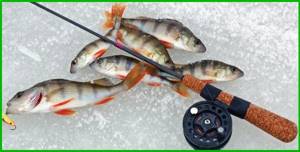
Thus, only avid fishermen who have tried all the listed types can know what the best fishing rod for perch should be. Fishing enthusiasts often create the best and most convenient gear for themselves, improve or create new models.
Clove or nail ball.
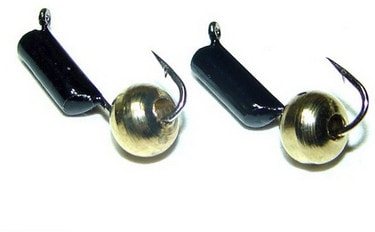
This is a baitless universal bait. It is a cylindrical jig (essentially a tungsten wire soldered onto the shank of a hook) with an eye, on the hook of which a brass (precisely brass, this is important) ball is placed. The hook size is sufficient for the ball to move freely. The peculiarity of this bait is to move and tap the ball on the shank of the hook when playing.
The game is most productive when changing the tempo of twitching from high to low.
This bait is attached to a loop in any way, without covering the forearm.
Jigs of the “nailball” type work well even in the most unbiting conditions ; they are catchy not only for perch, but also for other types of fish.
Perch (cat's) eye.
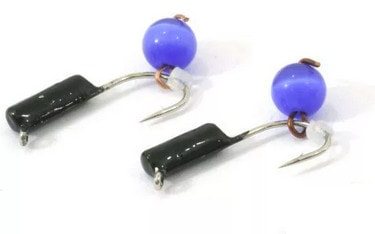
Many anglers believe that this is the most catchy jig for perch. Essentially, this is the same carnation, although the shape of the bait can be different (drop, uralka, ovsinka, dracena), on the hook of which is attached a ball painted to look like a fish eye, or a translucent bead with a mother-of-pearl tint similar to a cat's eye. The bead can be put on the hook itself or attached to it with a loop.
The main feature of this jig is that it is lighter than a nail ball and works great in shallow water, creating a more dynamic game. They play with smooth oscillatory movements, which become more frequent the more active the bite is.
They knit “Cat’s Eye” by the fore-end, having first passed the line through the eye, so that it is at an angle of 450.
This bait works not only on perch, but also on other types of fish, selecting its own shade of the ball for each. Perch loves such baits equipped with yellow and orange “eyes,” green for roach and ide, and white pearl for bream. But there is always room for experimentation.
What should you pay attention to when choosing the right gear?
Many fans of winter perch fishing choose a thicker fishing line, for example, 0.16 mm, because they want to be prepared in advance for the fact that a large specimen of this predator may bite. Another part of the fishermen, who welcome a sporty approach to fishing, prefer thin lines of 0.05 or 0.06 mm. Such fishing rods can withstand a weight of no more than a few grams, so you should be prepared for the fact that if a large and heavy fish bites, it will be very difficult to pull it onto the ice.
Neither the first version of the above example of gear, nor the second, is suitable for winter perch fishing. The most optimal fishing line size is 0.09-1 mm. If you believe that you can catch a trophy specimen weighing about half a kilogram, it is advisable to choose a stronger fishing line, but with a maximum thickness of 0.12 mm.
The main thing is to remember that the thicker the fishing line, the more problems may arise with the jig; it will take a long time to sink to the bottom and will actually become not very attractive to perch. Of course, these factors will not have a very good effect on the fish bite and your final catch. There is a high probability that the fish will not bite at all on a thick fishing line, but at the same time will look for food for itself under the hole. In fact, any test specimen can be handled using a fishing line no larger than 1 mm.

When buying fishing line, also pay attention to the fact that not all fishing tackle manufacturers honestly and correctly write their characteristics on their products. Often, companies engaged in this type of activity may indicate parameters that are far from the truth. This situation often happens with inexpensive fishing lines, so it is better not to purchase a product that is too cheap, but rather buy time-tested brands that have positive reviews from satisfied customers. It is believed that a good winter fishing line 30 or 50 m long will cost at least three dollars.
You should also pay attention to how much fishing line should be wound on one fishing rod. Of course, you shouldn’t use the entire length of fishing line for this, but it would also be unreasonable to wind less than 15 meters. It is most convenient to divide one line from a skein into two parts, and then wind it on two fishing rods. It will be approximately 20-25 meters for each. If you bought a 100 m long fishing line, divide it into 4 or 5 parts.
The choice of fishing line is, of course, important in fishing, but the main success of this activity can be attributed specifically to the jig. How to choose it correctly? Firstly, it should not sink to the bottom, and secondly, it should not be too light. Finding a compromise is often quite difficult. Preference should be given to products made from tungsten alloy, since they are lightweight and compact, unlike the same ones made from lead.
In fact, lead jigs have a serious drawback: they have a small and blunt hook. But this does not apply to all manufacturers, so you should not completely write off the use of lead jigs. For Russian reservoirs with weak currents or its complete absence, products that weigh 0.2-0.3 grams are well suited. The size of tungsten jigs should be 2-0 mm in diameter, and lead jigs should be 3-4 mm.
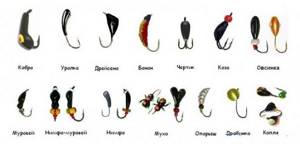
The shape and color of the jig do not play as big a role as is commonly believed. The same applies to the number of bloodworms attached to the hook. It’s rare to find a perch that is picky about the size of the bait. As a rule, the bite is not affected by how many bloodworms you put on the hook, one or a whole bunch. The most popular quantity is two or three larvae. If the bite is good, then one will be enough. Make sure that the jig is not empty, because the cunning perch often pulls it off the hook. In this case, as soon as the fish has dragged the bloodworm, it will immediately move away from your chosen fishing spot, and it will be almost impossible to lure it back.
It is also important to carefully consider the parameters of the nod; as a rule, it is selected according to the weight of the jig, and in some cases - to the characteristics of the game. There is no point in stocking up on a large number of fishing rods for every special occasion, there is simply no point in doing so. It is much more convenient to have several, which will differ in the thickness of the fishing line and the weight of the jigs (3-4 different types). Experienced fishermen advise giving preference to nods approximately 5 cm long and about 3 cm wide. It is generally accepted that a cone-shaped nod will be the most sensitive, but this is not such a critical point.
Heated discussions sometimes revolve around the angle of the nod to the fishing rod. The most optimal angle is 45-60 degrees, although some anglers may disagree with this. If you want the nod to be clearly visible against a white background, paint it a bright color, such as red. An ordinary nail polish or a marker with a waterproof effect is perfect for this.
The following should also be said about the fishing rod. It is not customary to place too strict demands on it, but most fishing enthusiasts agree that it should be light, convenient, and its use should be comfortable. If the fishing rod fits comfortably in your hand and has a cool handle, feel free to choose it.
An ordinary fishing rod is 20-25 cm long, the reel should not get stuck for any reason, the whip should be soft and thin. A classic in fishing is a balalaika-shaped design, but this is not the only option that is suitable for catching perch in winter.

Banana.

This jig made a splash among fishermen at one time, and remains loved and popular to this day.
It is named so because its shape resembles this particular fruit. They are available in different colors and sizes, but the most catchy ones are considered to be up to two centimeters long. Used in calm water and in shallow currents, at a depth of up to 6 m.
It can be used with or without attachments. When fishing without bait, they play it quickly and roughly. When playing, the bait, moving in a vertical plane, oscillates along the plane of the hook around the center of gravity in one direction or another.
You can tie it either by the eye, for freer play, or by the fore-end.
successfully catch both perch with it , using “bananas” of bright colors, and roach with bream ; lures of calm colors are suitable for them.
We recommend that you familiarize yourself with the ten most catchy wobblers and spinners for winter pike fishing
Uralka.

Another winter classic. A very well-known, common and popular bait. Suitable for both baitless fishing and fishing with bait.
It resembles a slightly elongated and inwardly curved drop, with the wide end up. With its shape and game it imitates the small crustacean amphipod (mormysh).
Playing "Uralka" is quite simple, it actually does everything itself, so it is easy for beginners to master . When fishing without bait, it is better to supplement the jig with a colored bead or cambric. Of course, each body of water requires the selection of its own “Uralka” by type and size, but in general, any of them will work successfully.
“Uralka” usually comes without an eye, so they tie it by the fore-end, passing the fishing line through the hole in the jig, as a result, the hook will be at an angle to the fishing line.
Uralka is excellent at catching not only perch, but also roach, bream and other fish.
Jigs for catching perch
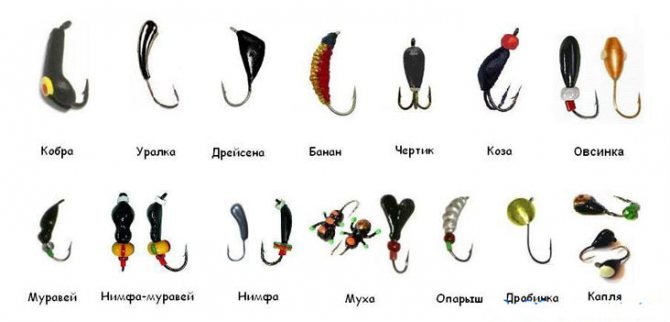
Perch bites on almost any jig, but especially prefers dark colors . When choosing, first of all, you should pay special attention to black, red, dark green.
Yellow, silver and copper colors are also often used.
Also, the size of the jig plays an important role. In the spring and summer seasons, the size can be larger, approximately from 3 to 5 mm, than in winter, since the water during the ice-free period is saturated with oxygen and the perch actively feeds.
In winter, it is recommended to choose small sizes of 2-3 mm, and when fishing in shallow water in standing water - 1 mm. This is explained by the fact that when lowering the jig under the ice, it will not sink for a long time and be carried away by the current.
But if the pond has a depth of 4 to 6 meters, and there is a current, then the weight of the bait should be changed to a heavier one. The size also depends on the habits of the fish in a given weather.
In sunny winter weather with slight frost, the activity of the perch increases, and accordingly its bite is active, so a medium-sized jig will perfectly lure a hungry predator. With the onset of February, the activity of perch decreases, finding and especially catching it becomes more difficult.
mothless
In this case, jigs with a small shot will significantly increase the chance of catching.
As for the shape, complete freedom of choice is given here, since a hungry predator bites on any type of jig. But baits such as “devil”, “goat” and “ant” have proven themselves well. The devil is a drop-shaped black pellet with a treble hook.
Works great almost any time. When playing intensively with the “devil,” vibrations are created in the water, which lure the perch and provoke it to grab the bait, and the presence of a treble hook will help significantly reduce the number of fish. The “goat” differs from the devil only in the presence of hooks.
There are 2 of them on this jig. The ant is made of two pellets connected to each other into which a hook is soldered. However, relying only on these 3 types of jigs is also not advisable.
Experienced fishermen use their entire arsenal of catchable baits to determine which bite is the most intense in a given water area.
The hooks of jigs must be sharp and not show signs of rusting. It’s not uncommon for professional fishermen, when buying a jig in a store, to pay attention to the hook. If its tip is parallel to the pellet, then they bend it towards the shank of the hook at an angle of 60 degrees.
This reduces the chance of the perch getting off the hook.
Also, there is a reelless version of jigs. They are called that because when fishing, the bait, mostly bloodworms, is not put on at all.
As a replacement for bait, different colored beads or beads are placed on the shank of the reelless fish, while the tip of the hook remains bare. The main color of the bead when fishing for perch is considered to be red, since it resembles a bloodworm when playing with a jig. But for the sake of experiment, you can look for your catchy colors of a reelless jig.
Nymph.
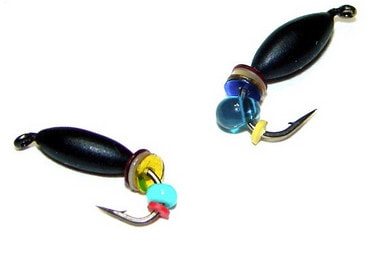
It is a bait with an ear, elongated spindle-shaped or teardrop-shaped. Its main design feature is 2–3 bright disks placed on a hook, the displacement of which is partially limited by the cambric. Thanks to them, when displaced vertically, the “nymph” simultaneously oscillates in the vertical plane. The classic color is black, but it also comes in other colors.
It is optimal to use a nymph at a depth of two meters, maximum five, in calm water.
They play with a “nymph” smoothly, making small amplitude oscillations. Their frequency is determined in accordance with the conditions of the reservoir, the weight of the “nymph”, and the type of intended catch. They always start playing with this jig from the bottom. Having made several movements with relatively wide strokes and a fairly fast rise, they make slow, careful movements.
They tie it both by the fore-end and by the eye, for freer play.
The most effective “nymph” is for catching perch, roach, ide and rudd. In addition to them, silver bream and bleak are caught.
Where to look for perch
So, the best time to catch perch is on the eve of winter. A week later, after the ice has formed, the activity of the perch increases sharply (it can be compared to a meal before spawning). Now, until severe frosts hit, the perch is in the coastal zone in its natural habitat. Preference is given to grassy or snagged shallows, headlands and bays. Perch loves a hard, pebble-sand bottom, strewn with snags.
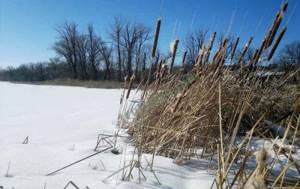
It also lives on the bottom covered with silt, but there should not be too much of it. It can also be found on the border with aquatic vegetation or in places where other artificial and natural shelters are available.
Towards the end of December, the activity of perch decreases significantly, and in addition, previously large schools that formed in the fall disintegrate. Nowadays, finding a school of minke whales numbering over 10 individuals is a great success. The perch leaves the coastal zone, but as before, it tries to stick to the shallows that are adjacent to holes, river beds or dumps; there is a high chance of meeting it on the shallows between the holes. You should also look for perch in old river beds and in areas where rivers and streams flow into the reservoir. The depth at which perch prefers to stay is 2 - 3.5 m. You should look for perch in holes and pools only during periods of severe frost. Due to the decrease in the activity of stripers, catching perch in winter with a jig will be most effective, because a jig is the most delicate equipment.
At the beginning of spring, perch becomes active again and disperses throughout the entire reservoir; moreover, it can more often be found in various layers of water. This is especially true for large perch, which can be located a few centimeters from the ice edge.

In winter, perch bite throughout the day; it is quite difficult to say which time is best for fishing for stripers, since now they are very capricious and can be passive all day long; once they start feeding, they feed only in the evening. It has been noted that the evening bite is the shortest.
Perch loves windless, frosty days, the main thing is that the atmospheric pressure is stable and the frost is not lower than 15˚C.
Ant.
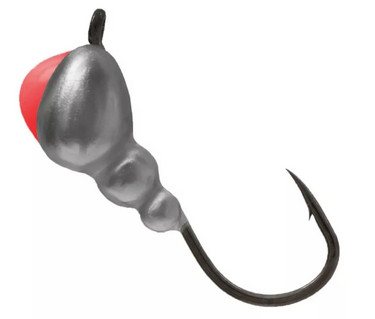
The “Ant” jig, originally a baitless bait, thanks to its popularity, has become so widely used that it has become almost universal. It is used with bait, and in the “Nymph-ant” modification with discs, and with a cat’s eye, and with other attachments.
It is a slightly curved metal body of an elongated oval, cylindrical or teardrop shape, segmented along the length into two or three parts. The most popular color is black, but there are many other colors, for example for perch - bronze in color with bright colored eyes on the sides. For fishing with bait, tungsten jigs are better suited; for fishing without bait, lead jigs are better suited.
The “ant” demonstrates its greatest effectiveness when fishing at the end of winter.
The main feature is the ability of this bait to actively move in the horizontal plane without changing its vertical position. When fishing with an ant, the best results were those with a high oscillation frequency and a very slow rise. The lifting height of the bait when retrieving should be at least half a meter. If bites occur high from the bottom, it makes sense to lift up to a meter.
The ant is usually tied by the fore-end, passing the fishing line through the eye.
Jigs of the “ant” type, no matter what variants are used, work best for roach and perch; in addition, they successfully catch white bream, rudd, ide and other white fish.
Goat.
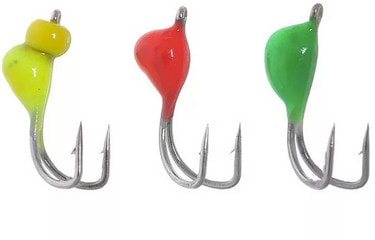
Another widespread, popular nozzle jig. Many consider it a subspecies of the “devil”, but in its essence and appearance it is more similar to the “Uralka” with two hooks. Although lately there have been quite a lot of modifications with two hooks of different types of jigs, “ant”, “nymph”, “banana”.
In appearance it is a jig, most often of the “Uralka” type, less often “devil” with two hooks set at an angle of 450. There is another type of goat - the cuttlefish goat, similar to the “Uralka” turned upside down and slightly flattened, where the hooks come out wide part. Place two foam balls on the hooks.
The advantage of the “goat” over other jigs is the greater likelihood of hooking a fish , and over the “devil” in the fact that it is easier to remove (those who have retrieved a deeply swallowed “devil” from a perch, I think, will agree). In addition, the third hook of the “devil” often does not help, but rather scares away the fish that has pricked itself on it.
Due to its shape, the goat's game is similar to the "Uralka". In addition, the “Goat” can be further unbalanced by placing a bead or disks on one of the hooks. Therefore, playing it is not very difficult. The frequency and amplitude of oscillations are selected in each specific case. So, when catching perches, the “saw” or “dribbling” most often works, when the tip is lowered to the hole at an angle of 45°, be sure to use several rises up to a meter from the bottom, as when trolling, rises with pauses and small resets.
It is usually tied by the shank of one of the hooks so that the bait is at an angle to the fishing line.
All active fish are caught with the “goat” - perch, white bream, silver bream, rudd, crucian carp, pike perch and even pike. But most often it’s roach and perch.
When biting actively, especially from perch, the fish swallows the jig quite deeply, and the more hooks the bait has, the more difficult it is to remove it. Remember this when arming yourself with a “devil” or “witch”
Types of postings
Tapping method . For beginners and fishermen who do not like to be too clever, catching perch in winter with a jig is preferable to one simple, but quite catchy retrieve. We lower the tackle to the bottom and make three or four taps on the bottom, while the jig rises to a height of no more than 3-4 cm, after which the tackle sinks to the bottom, and we pull the fishing line. We wait in this position for 5-10 seconds and slowly unwind the tackle. At the same time, we are in constant readiness for a perch to bite, because it can be in different layers of water. In this way, two entries are made, and if there is no result, we move on to the next holes.
Stepped wiring . We lower the bait, and when there is about a meter left to the bottom, we begin to swing it from side to side, smoothly lowering it to the bottom. As soon as it reaches it, we wait a few seconds; quite often active fish bite at this very moment. If the bite does not occur, we again raise our jig to a height of 50 cm and begin to make circular movements with the fishing rod with gradual acceleration. Then the jig sinks to the bottom again. We repeat this wiring three times. It is on the third rise that the perch most often bites.
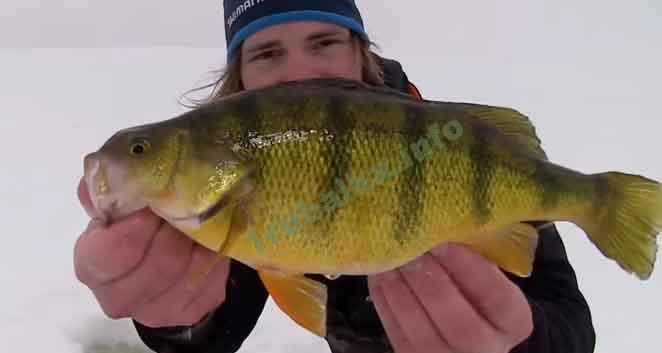
Combined wiring . We lower the jig into the hole and wait until it reaches the bottom. Now we lift the tackle 30-35 cm from the bottom and tug lightly, creating slight vibrations of the tackle. Then we put the jig on the bottom again and tap 4-6 times on the bottom and slowly raise it to a height of 6-8 cm, pause for 5-10 seconds and lower the jig back to the bottom. Then slowly raise the jig to a distance of 20-30 cm from the bottom and lightly, but at regular intervals, hit the whip with your finger for 20-25 seconds. The tackle is lowered back and the procedure is repeated several more times; if the perch does not respond, then we move on to the next hole. Winter fishing for perch with a jig with this type of fishing is quite effective, since it combines techniques that make the jig react differently.
Posting on the eve of spring. The essence of this wiring is that our game begins not in the bottom layer, but immediately at the edge of the ice at a distance of 60-80 cm. We smoothly lower the tackle to the bottom, while simultaneously swinging it from side to side. When the bait lies on the bottom, we perform 2-3 taps. Then we wait a little and knock again. Then slowly raise the jig 15-25 cm from the bottom and lower it again. After 20-30 seconds, we unwind the tackle and repeat the wiring again.
Devil.
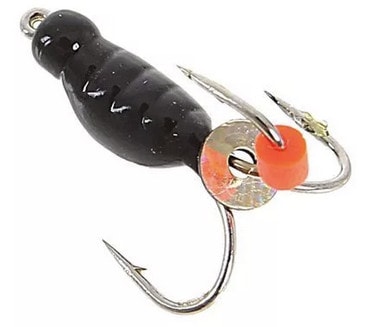
The shape of the jig varies, from round to elongated. The tee can be attached freely; it is often equipped with beads, circles and cambrics. Sometimes several “devils” are combined into a garland, attaching several to one leash at different heights.
They play the “devil” smoothly, raising it step by step from the bottom, with a medium or low frequency of oscillations, with periodic pauses.
They attach it vertically, depending on the type, either by the eye, or by passing the fishing line through the body of the bait by one of the hooks.
The “devil” jig perfectly catches perch, potwa, bream, silver bream, pike perch and other fish.
Medusa, witch or fool.
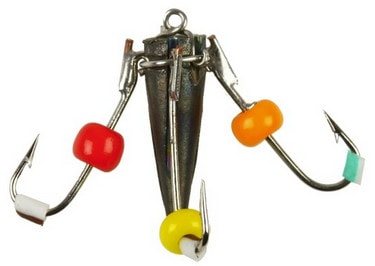
What all these jigs have in common is that they have hooks with beads loosely attached to their body.
In shape, it is an elongated weight with a loop, to which three, less often four, hooks equipped with beads with cambrics are loosely attached. “Balda” differs only in that it has two hooks attached to a weight on a loop of fishing line.
When playing such a bait, it moves slightly chaotically, and the hooks oscillate up and down, creating the illusion of the movement of the legs of a crustacean or other aquatic insect. In addition, they create additional vibrations, clicks and other noise that attracts fish .
The game of this “Witch” should begin with several blows to the bottom, then with smooth, slightly sweeping movements, lifting it up to a meter. But in general, the manner of play should be selected for each individual case and body of water.
Almost all white fish are caught with such a jig: white bream, roach, rudd, silver bream, perch also loves it, and even pike will not refuse larger baits.
